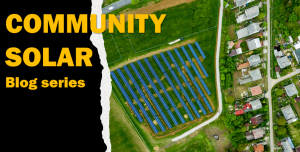Community Solar – An Introduction to Community Solar in Maryland
By David Comis, Senior Energy Program Manager
This is part one of a 7 part series on community solar.
Please note, the comments in this blog are the personal opinions of the author and do not represent the views of the Maryland Energy Administration or the State of Maryland.
Community Solar allows residents to receive the benefits of solar from a photovoltaic system installed in the local community. Community solar programs are designed very differently in each state. This article discusses community solar as practiced in Maryland, and compares it to an onsite solar installation.
Let us assume you are at home using an electric stove for an hour, and have a solar array on the roof of your home. During the hour, the stove uses 2 kilowatt-hours (kWh) of energy in the form of electricity. The solar array on your roof produces 1.5 kWh of electricity during this period which is used by the stove without going through your electric meter. As such, your electric meter will only show the net use of 0.5 kWh for this time period.
However, a study by the National Renewable Energy Laboratory found that about 75% of the households in the United States were not good candidates for solar because a) they were renters; b) their roofs were severely shaded; c) the roof would not support the weight of a solar system, did not have a flat area, or was pointed in the wrong direction; or d) some other problem. Many in this group of 75% of households would like to use and support solar energy, so legislation was developed to allow this to occur. Rather than place the solar panels on your roof, the solar panels can be placed at another location and, you will get credit for the energy produced, just as if the panels were on your roof. On your monthly bill, the utility company credits your bill for the energy produced by your solar panels at the remote location. This is the basis of the community solar program in Maryland.
In addition, in Maryland we are allowed to net meter our solar energy generation. Using the same example as above, suppose that your solar panels produced the same 1.5 kWh of electricity, but you were out of the house and everything was turned off. What would happen with the energy produced.by the array? As allowed by net metering, the 1.5 kWh would be sent to the electrical grid, turning your electric meter backwards and earning you a bill credit for future electricity bills. When you get home that night and turn on the lights, you start using energy, making your electric meter run forward, using up the energy credits that you earned by having your excess energy fed into the grid.
Throughout the month, your solar system will produce power that you either use on the spot, or that you send backward through your electric meter. At the end of the month, the electric utility compares your electric meter reading with the reading at the beginning of the month. If the meter reading is higher, then you pay for the net amount of electricity that you used. However, if the meter is lower than the meter reading at the beginning of the month, then you have effectively used no electricity for the month. You only pay the fixed charges due to the electric utility (the account charge and Universal Electric Service Charge, and some surcharges – totaling approximately $8.36/month) and the energy that you sent back to the grid is effectively banked for you, to be used during the next month. This happens each month until April of each year, when the utility pays you (cash) for any excess energy credits that remain. However, they will not pay you the full retail rate, but only the average rate that they paid for electricity during the year (see your individual utility’s community solar tariff for specific details).
This works for community solar also. Each month the utility subtracts the amount of energy generated from your “share” of the remote community solar installation from the energy consumed by your house or apartment. If more energy is produced than you consumed, the excess energy is banked for you for the next month. When you combine community solar with net metering, you have something called virtual net energy metering. Maryland has virtual net energy metering.


 1-888-373-7888
1-888-373-7888 233733
233733